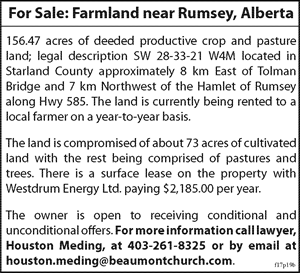
The extreme Alberta weather has made it a challenging year for the area’s farmers.
Starland County’s Agriculture Fieldman Al Hampton said the belt from Red Deer to Calgary that includes Drumheller and Starland County, has the highest probability of hail in Western Canada.
So between the hail, rain, snow and frost, crops have been wiped out, flattened, or had their profitability diminished because of the extra work required to bring the crops in and the downgrade in the rating of crops.
Add to that lower commodity prices, and it all adds up to tighter margins and makes paying bills a bit more interesting, said Hampton.
He adds this year’s farming season, perhaps coming back to what most people remember as more normal, was a change over recent years.
“Over the past five years it has been relatively profitable in the farming industry.”
He said last fall was quite dry, and personally, he thought this year’s season might be hotter and drier.
Another factor affecting Canadian crop producers this year is the projected size of U.S. crops.
He said the U.S. is indicating that corn and bean production are on a record pace, and with corn being king, it means Canadian grains will pay the price.
“If you’re looking at markets, you can pretty much guarantee, until they get the corn crop off in the United States, and they’ve got a monster, you’re going to see lower and lower prices,”
Hampton said while farm producers’ recent struggles include commodity prices that are on a downward slope, possibly into December/January, lagging beef prices are on the rise.
“So for the cattle producer, things are finally looking not too-bad.”
He said reasons for the rise in cattle prices include a decline in the big herds in the U.S. over the past ten years, as well as herd numbers decreasing in Canada, with BSE taking a bite out of the cattle industry.
The Canadian cattle herd numbers are pretty low, “So we have more demand than we have supply right now,” said Hampton.
He said the supply-demand dynamic means beef has gone up accordingly, with beef on the rise from around $1.50-plus per pound U.S. as of September 19.
Hampton said beef prices started on the upward trend last fall - it was around November the cattle prices started its steady climb.
Hampton said a continued rise in beef prices means consumers will see a corresponding rise on the sticker price at their local grocery store.
He said if beef prices get too crazy, consumers will probably look to switch over to more reasonably priced alternatives, such as pork, chicken and turkey, and possibly lamb.



























